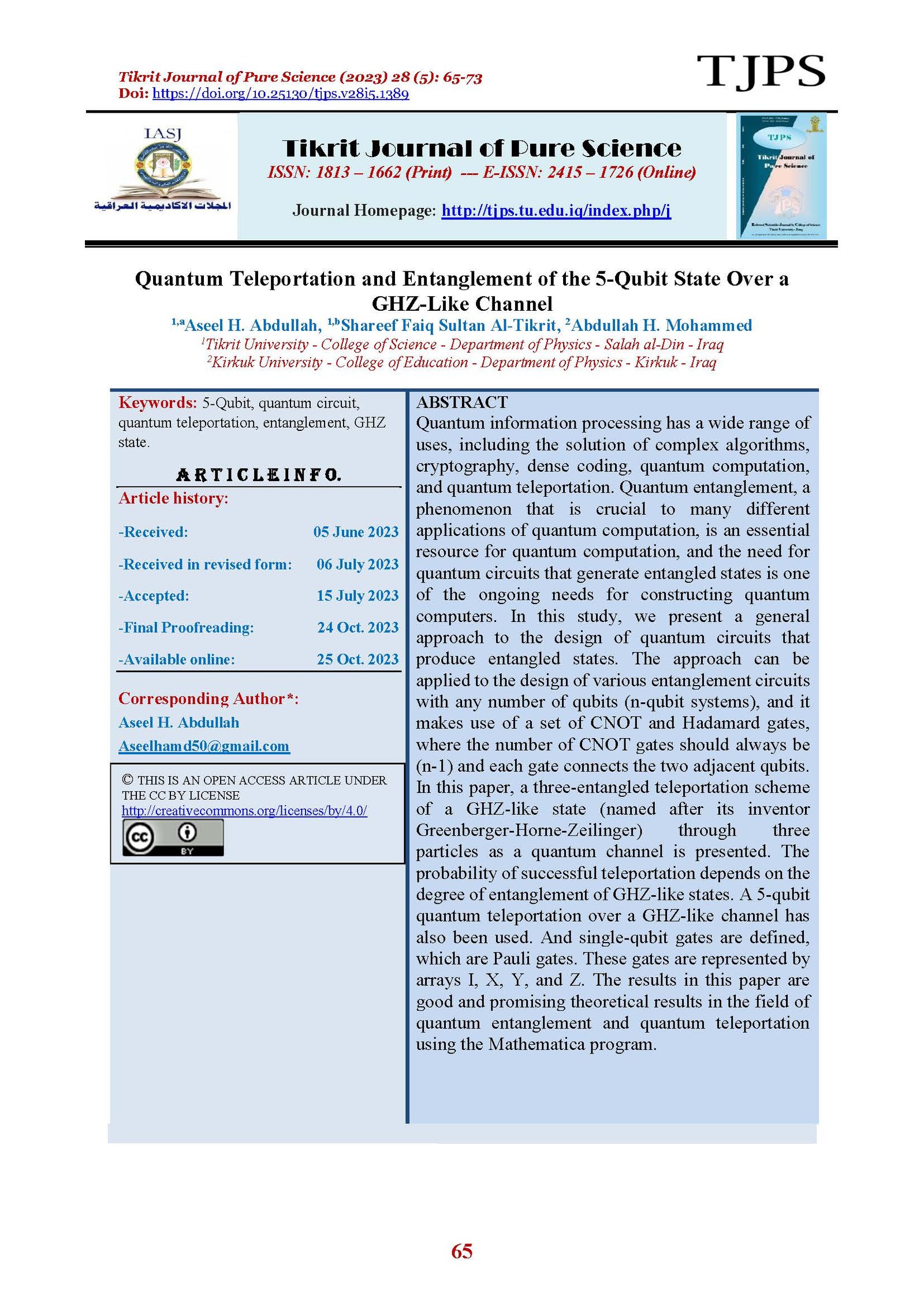Quantum Teleportation and Entanglement of the 5-Qubit State Over a GHZ-Like Channel
Main Article Content
Abstract
Quantum information processing has a wide range of uses, including the solution of complex algorithms, cryptography, dense coding, quantum computation, and quantum teleportation. Quantum entanglement, a phenomenon that is crucial to many different applications of quantum computation, is an essential resource for quantum computation, and the need for quantum circuits that generate entangled states is one of the ongoing needs for constructing quantum computers. In this study, we present a general approach to the design of quantum circuits that produce entangled states. The approach can be applied to the design of various entanglement circuits with any number of qubits (n-qubit systems), and it makes use of a set of CNOT and Hadamard gates, where the number of CNOT gates should always be (n-1) and each gate connects the two adjacent qubits. In this paper, a three-entangled teleportation scheme of a GHZ-like state (named after its inventor Greenberger-Horne-Zeilinger) through three particles as a quantum channel is presented. The probability of successful teleportation depends on the degree of entanglement of GHZ-like states. A 5-qubit quantum teleportation over a GHZ-like channel has also been used. And single-qubit gates are defined, which are Pauli gates. These gates are represented by arrays I, X, Y, and Z. The results in this paper are good and promising theoretical results in the field of quantum entanglement and quantum teleportation using the Mathematica program.
Article Details

This work is licensed under a Creative Commons Attribution 4.0 International License.
Tikrit Journal of Pure Science is licensed under the Creative Commons Attribution 4.0 International License, which allows users to copy, create extracts, abstracts, and new works from the article, alter and revise the article, and make commercial use of the article (including reuse and/or resale of the article by commercial entities), provided the user gives appropriate credit (with a link to the formal publication through the relevant DOI), provides a link to the license, indicates if changes were made, and the licensor is not represented as endorsing the use made of the work. The authors hold the copyright for their published work on the Tikrit J. Pure Sci. website, while Tikrit J. Pure Sci. is responsible for appreciate citation of their work, which is released under CC-BY-4.0, enabling the unrestricted use, distribution, and reproduction of an article in any medium, provided that the original work is properly cited.
References
[1] Bennett, C.H.; Brassard, G.; Crepeau, C.; Jozsa, R.; Peres, A. and Wootters, W.K. (1993). Teleporting an unknown quantum state via dual classical and Einstein-Podolsky-Rosen channels. Physical Review Letters, 70:1895–1899.
[2] Dür, W.; Vidal, G. and Cirac, J.I. (2000). Three qubits can be entangled in two inequivalent ways. Physical Review A, 62:062314(1–12).
[3] Shi, B.S.; Jiang, Y.K. and Guo, G.C. (2000). Probabilistic teleportation of two-particle entangled state. Physics Letters A, 268(3):161–164.
[4] Wilde, M.M. (2019). Quantum information theory. 2nd ed., Cambridge University Press, arXiv:1106.1445 pp.774.
[5] Khatri, S., and Wilde, M.M. (2020). Principles of Quantum Communication Theory: A Modern Approach. arXiv. /abs/2011.04672: pp.971.
[6] Cai, X.F.; Yu, X.T.; Shi, L.H. and Zhang, Z.C. (2014). Partially entangled states bridge in quantum teleportation. Frontier of Physics, 9:646–651.
[7] Piattini, M.; Peterssen, G. and Pérez, R. (2021). Quantum computing: A new software engineering golden age. ACM SIGSOFT Software Engineering Notes, Association for Computing Machinery, 45(3):12–14.
[8] Piccitto, G.; Russomanno, A. and Rossini, D. (2022). Entanglement transitions in the quantum Ising chain: A comparison between different unravelings of the same Lindbladian. Physical Review B, 105(6):219901.
[9] Sisodia, M.; Shukla, A.; Thapliyal, K. and Pathak, A. (2017). Design and experimental realization of an optimal scheme for teleportation of an n-qubit quantum state. Quantum Information Processing, 16:292(1–11).
[10] Singha, R.; Sarkar, S.; Ghosh, A. and Roy, S. (2023). Signatures of topological surface state and unconventional magnetotransport properties in elemental Ruthenium. Advanced Quantum Technologies, 6(3):2200116(1–8).
[11] Sisodia, M. (2020). Design and Analysis of Communication Protocols using Quantum Resources. Ph.D. thesis, Declared Deemed to be University, Noida, India.
[12] Çelik, N. and Nüket, Ü. (2022). Producing maximally entangled Bell type states in an efficient way for quantum teleportation. Chinese Journal of Physics, 79:192–201.
[13] Tabatabaei, L.S. and Vakili, B. (2023). Bi-directional quantum teleportation of GHZ-like states. arXiv. /abs/2302.11300:1–13.
